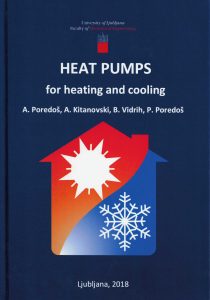
Alojz Poredoš … [et al.]
2018, 1. izd.
[VI], 199 str.
ISBN 978-961-6980-46-3
Enotna cena: 15,00 €
Table of Contents
1 Introduction …………………………………………………………………………………………………………. 1
1.1 The importance of heating and cooling ……………………………………………………………… 2
1.2 The definition of a heat pump ………………………………………………………………………….. 2
1.3 A brief discussion on the thermodynamics of heating and cooling with
heat pumps……………………………………………………………………………………………………………… 3
1.3.1 Exergy and anergy of heating and cooling …………………………………………………….. 7
2 Thermodynamics and characteristics of vapour-compression heat pumps ………………….11
2.1 Carnot heat-pump cycle …………………………………………………………………………………..11
2.2 Compressor-driven vapour-compression heat-pump cycle …………………………………14
2.2.1 Heat-pump device with an expansion element …………………………………………….. 15
2.2.2 Suction of dry refrigerant vapour …………………………………………………………….. 16
2.2.3 Subcooling …………………………………………………………………………………………… 18
2.2.4 Superheating ………………………………………………………………………………………… 21
2.2.5 Internal regeneration of heat …………………………………………………………………… 22
2.2.6 Polytropic compression ………………………………………………………………………….. 24
2.3 Coefficient of the performance and exergy efficiency of vapour-
compression refrigerators and heat pumps …………………………………………………… 26
3 Thermodynamics and characteristics of sorption refrigerators and heat pumps ……………… 30
3.1 An introduction to the thermodynamics of sorption refrigerators and
heat pumps ……………………………………………………………………………………………. 30
3.2 The thermodynamics of absorption refrigeraton and heat pumping …………………… 33
3.2.1 The thermodynamic cycle of single-stage absorption refrigerators and
heat pumps …………………………………………………………………………………………… 34
3.2.2 The thermodynamic cycle of double-stage absorption refrigerators
and heat pumps …………………………………………………………………………………….. 39
4 Heat-pump elements and their characteristics ………………………………………………………….. 42
4.1 Compressors …………………………………………………………………………………………….. 42
4.1.1 Positive-displacmenet compressors: Reciprocating (piston)
compressors …………………………………………………………………………………………. 42
4.1.2 Positive-displacmenet compressors: Screw compressors …………………………….46
4.1.3 Positive-displacement compressors: Compressors with rotary pistons:
Roll ing Piston or Stationary-Vane Rotary Compressor ……………………………….. 47
4.1.4 Positive-displacement compressors: Compressors with rotary pistons:
Rotary-Vane Compressor ……………………………………………………………………….. 48
4.1.5 Positive-displacement compressors: Rotary-scroll compressors …………………… 49
4.1.6 Rotary centrifugal (turbo) compressors ……………………………………………………… 50
4.1.7 Volumetric efficiency of piston compressors ……………………………………………….. 51
4.2 Evaporators/Condensers …………………………………………………………………………….. 51
4.2.1 Boiling …………………………………………………………………………………………………… 52
4.2.2 Condensation …………………………………………………………………………………………. 54
4.2.3 External (outdoor) units of condensers or evaporators (air-to-refrigerant) ……….. 56
4.2.4 Compact (indoor) units of condensers or evaporators (water-to-refrigerant)…….. 57
4.2.5 Shell-and-tube units of evaporators and condensers …………………………………… 58
4.2.6 Throttling/Expansion devices ……………………………………………………………………. 59
4.2.7 (De)Frosting process ………………………………………………………………………………. 61
4.2.8 Reverse operation of the heat pump ………………………………………………………… 62
5 Refrigerants …………………………………………………………………………………………………………… 66
5.1 Environmental, safety and chemical-stability properties ………………………………….. 69
5.1.1 Ozone Depletion Potential (ODP), Global Warming Potential (GWP)
and Total Equivalent Warming Index (TEWI) ……………………………………………… 69
5.1.2 Toxicity and flammability …………………………………………………………………………. 70
5.1.3 Chemical stability of refrigerants ………………………………………………………………. 72
5.2 Thermodynamic and thermo-physical properties …………………………………………….. 72
5.3 Future heat-pump refrigerants ………………………………………………………………………. 73
6 Heat sources and types of heat pumps ………………………………………………………………………. 75
6.1 Air source heat pumps (types and performance) …………………………………………….. 81
6.1.1 Air-water hydronic heat-pump systems ……………………………………………………… 82
6.1.2 Air-air refrigerant circuit heat-pump systems ……………………………………………… 89
6.2 Water-source heat pumps (types and performance) …………………………………………91
6.2.1 Water-water hydronic heat pumps (types and performance) …………………………93
6.2.2 Water-air refrigerant circuit heat pumps (types and performance) ………………101
6.2.3 District heating/cooling with heat pumps ………………………………………………….. 102
6.3 Ground-source and geothermal heat pumps (types and performance) ………….109
6.4 Assisted heat pumps with different heat sources …………………………………………… 116
6.4. I Types ofheat pump’s operation modes …………………………………………………….. 118
6.4.2 Solar-assisted heat pumps ……………………………………………………………………. 120
6.4.3 Gas- or biomass-assisted heat pumps ……………………………………………………. 126
6.4.4 Compact hybrid heat pumps …………………………………………………………………. 127
6.4.5 District-heat-assisted heat pumps ………………………………………………………….. 127
7 Thermal storage and sanitary hot-water tanks ………………………………………………………… 128
7.1 Short- and medium-term thermal storage systems ………………………………………. 132
7.1.1 Sanitary water and residential buffer storage tanks ………………………………….. 132
7.2 Long-term seasonal thermal storage …………………………………………………………. 140
8 Internal heating systems ………………………………………………………………………………………. 144
9 Dimensioning of heat pumps ………………………………………………………………………………… 150
9.1 System design requirements …………………………………………………………………….. 150
9.2 Dimensioning the heat-pump system …………………………………………………………. 152
9.2.1 Design transmission heat loss for a heated space …………………………………… 153
9.2.2 Internal design temperature ………………………………………………………………….. 156
9.2.3 Climate data ……………………………………………………………………………………….. 157
9.2.4 Design ventilation heat loss for a heated space ……………………………………….. 157
9.3 Sizing heat-pump capacity for sanitary hot water ………………………………………….. 158
9.4 Dimensioning the heat source of the heat-pump system ………………………………… 161
9.4.1 Air heat-source …………………………………………………………………………………….. 161
9.4.2 Underground water heat source ……………………………………………………………… 162
9.4.3 Ground source – soil heat exchanger. ………………………………………………………. 163
9.4.4 Ground source – borehole heat exchanger. ………………………………………………. 168
9.4.5 Surface water source – heat exchanger. …………………………………………………… 171
9.5 Dimensioning of the circulation pump …………………………………………………………… 172
9.6 Calculation of the total electrical energy consumption for electrically
driven heat pumps ……………………………………………………………………………………… 175
9.6.1 Meteorological data ………………………………………………………………………………… 175
9.6.2 Energy consumption calculation ………………………………………………………………. 176
9.6.3 Heat-energy requirement for space heating ………………………………………………. 177
9.7 Seasonal performance factor ……………………………………………………………………… 181
10 The economics of heat pumps ……………………………………………………………………………. 188
10.1 The return on investment (ROI) ………………………………………………………………. 189
10.2 Net present value (NPV) ………………………………………………………………………… 191
10.3 Operating life expectancy of devices ……………………………………………………….. 192